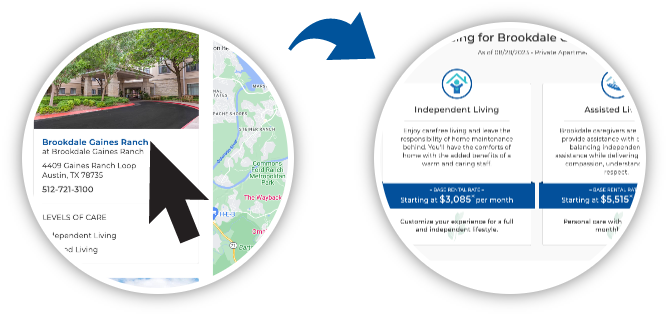- Home
- Brookdale Life
- Brookdale Blogs
- 8 Tips for Moving With Pets
1. Talk to your vet for specific pet needs.
The very first thing pet owners should do before moving is to consult their vet. “Based on your pet’s past health records, your vet might be able to suggest certain do’s and don’ts,” explains Voyo Popovic, CEO of Piece of Cake Moving & Storage. Be sure to pack any medications your pet needs for the ride. If your pet has anxiety, you should consider talking to your veterinarian about medications that may help them to remain calm while in transit.
2. Stick to your pet’s routine.
“Even through the hustle and bustle of organizing and packing, it’s important to continue your pet’s routine as much as possible,” says Marc Richard, senior vice president of operations for College Hunks, a moving and junk removal company. Take them for their normal walks, feed them at the same mealtimes, and if you have a special habit, such as going to the park on Saturdays, make sure that still happens so they don’t feel as if something is off. Keeping up with these habits can help to make a move less stressful on a pet.
3. Get pets used to crates (if they aren’t already).
Many pets haven’t spent much time in crates or cars. So in the weeks or months leading up to the big trip, Popovic suggests preparing your pets by gradually acclimating them to their travel bag or crate. Guide them into an open crate and reward them with treats and pets for going inside. Practice this repeatedly, then try shutting the door for short periods of time, gradually increasing the duration. The same thing can be done with a zip-up pet carrier. You can even take a trial drive around the block with your pet in its carrier to prepare for a lengthy car ride. “Taking these steps will make moving day a lot more comfortable,” says Popovic.
4. Keep pets out of the way.
Moving day means movers coming in and out to load boxes and furniture into trucks, packing remaining items and lots of foot traffic in the home. “On moving day, keep your pets away from the action and in a quiet room with the door shut,” suggests Popovic. You can also tuck a pet safely into a crate or carrier if there is no free room to have them relax in. This can help to keep them from getting injured or sneaking out the front door during the moving process.
5. Plan for long drives.
“If your move involves several hours of driving, make sure you have a plan,” says Richard. Map out places to stop so your pet can stretch their legs and relieve themselves during the ride. It’s also important to pack plenty of food and water to keep your pet satiated throughout the drive. You’ll also want to make sure your pet is comfortable and is safely contained in a pet carrier or strapped in with a seatbelt. If you’re flying on a plane, allow your pet to relieve itself before hopping on the flight. Bring any medications, snacks, blankets, or toys you need to help your pet remain calm.
6. Pet-proof your new place.
No matter where you live, the American Society for the Prevention of Cruelty to Animals (ASPCA) recommends taking steps to make your home pet friendly. For example, hide electrical cords so pets don’t have access to them, pick up small items on the floor that pets could ingest and block small spaces pets could get trapped in. When moving, make sure not to set boxes of things that could be toxic to pets, like medication or cleaning supplies, on the ground where your pet may be able to access it. Store these items up high in secure cabinets that even cats can’t access. And make sure all windows and doors are securely latched so anxious pets exploring a new home don’t accidentally escape.
7. Let them ease in.
A new home with new rooms to explore can be overwhelming to a pet. The ASPCA recommends allowing a pet to explore one room at a time. So, place a pet’s bed, food bowls, litter box, toys, etc. in this one room. Once they feel comfortable with that room, you can then move on and let them explore other areas in the house, gradually building your way up to giving them access to your entire apartment or house. Next, move your pet’s essentials to their new home base.
8. Place their essentials in familiar areas.
“Did your pet’s food used to be in the kitchen or their bed was placed in the corner by the couch? Put those items in the same places in your new home,” says Richard. Creating familiar surroundings as best as you can may help your pet adjust more quickly and recognize that this is their new home, too.
Categories
- Alzheimer's & Dementia
- Caregiver's Corner
- COVID-19
- Health, Safety and Wellness
- Financial Well-Being
- Passion & Purpose
- The Journey to Senior Living
- Trending Now
- Socialization & Relationships
- Brookdale Solutions
- Brookdale Vision and Growth
Archives
View All
- October 2025
- September 2025
- August 2025
- July 2025
- June 2025
- May 2025
- April 2025
- March 2025
- February 2025
- January 2025
- December 2024
- November 2024
X
Let us help find the right community for you!
Complete the form and a Senior Living Advisor will be in touch!
Inside Brookdale Communities
See what’s happening on our community Instagram pages
Brookdale has communities near you!



